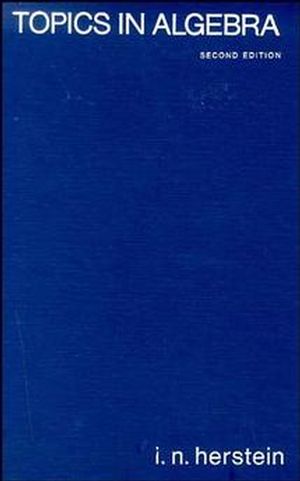Israel M Herstein's (March 28, 1923–February 9, 1988) Topics in Algebra is an undergraduate classic! The first edition was published in 1964 and the second edition in 1975. It originated from lectures Herstein gave to "gifted sophomores" at Cornell University in 1959-60. It was an attempt to bring traditional graduate-level abstract algebra topics into the undergraduate class. Now, of course, an abstract algebra class is a standard requirement for an undergraduate math degree.
The second edition of Topics in Algebra (on which these notes are based) is fairly thorough and suitable for use in ETSU's Introduction to Modern Algebra sequence (MATH 4127/5127-4137/5137). My book-of-choice for this sequence is John Fraleigh's A First Course In Abstract Algebra, 7th Edition (Pearson, 2002); see my online notes for Introduction to Modern Algebra 1 and Introduction to Modern Algebra 2.
The advantage of Herstein's book is that it includes some topics not covered in the Fraleigh book. It includes material on dual spaces, inner product spaces, and modules (in Chapter 4, "Vector Spaces and Modules"). It includes much information on an abstract approach to linear algebra in Chapter 6, "Linear Transformations" (on matrices, triangular matrices, Jordan forms, trace/transpose/determinates, and quadratic forms); this material would be a good introduction to my online notes for a graduate-level Linear Algebra class (which are based on Thomas Hungerford's Algebra [Springer-Verlag, 1974]). Additional interesting topics are:
- 5.2. The Transcendence of e.
- 7.2. Wedderburn's Theorem on Finite Division Rings. A proof that a finite division ring is necessarily a field is given.
- 7.3. A Theorem of Frobenius. A proof that a division ring which is algebraic over the real numbers is isomorphic to either the field of real numbers, the field of complex numbers, or the division ring of real quaternions is given.
- 7.4. Integral Quaternions and the Four-Square Theorem. A proof of the number theory result known as Lagrange's Four-Square Theorem (which states that every positive integer can be expressed as the sum of squares of four integers) is given using a subring of the noncommutative division ring of the quaternions.
The main purpose these notes is to present some of this supplemental material.
Copies of the classnotes are on the internet in PDF format as given below. The "Proofs of Theorems" files were prepared in Beamer. The "Printout of Proofs" are printable PDF files of the Beamer slides without the pauses. The "Proofs of Theorems" files have not been classroom tested and may have some typographical errors.
1. Preliminary Notions.
- Section 1.1. Set Theory.
- Section 1.2. Mappings.
- Section 1.3. The Integers.
- Study Guide 1.
2. Group Theory.
- Section 2.1. Definition of a Group.
- Section 2.2. Some Examples of Group.
- Section 2.3. Some Preliminary Lemmas.
- Section 2.4. Subgroups.
- Section 2.5. A Counting Principle.
- Section 2.6. Normal Subgroups and Quotients Groups.
- Section 2.7. Homomorphisms.
- Section 2.8. Automorphisms.
- Section 2.9. Cayley's Theorem.
- Section 2.10. Permutation Groups.
- Section 2.11. Another Counting Principle.
- Section 2.12. Sylow's Theorem.
- Section 2.13. Direct Products.
- Section 2.14. Finite Abelian Groups.
- Study Guide 2.
3. Ring Theory.
- Section 3.1. Definition and Examples of Rings.
- Section 3.2. Some Special Classes of Rings.
- Section 3.3. Homomorphisms.
- Section 3.4. Ideals and Quotient Rings.
- Section 3.5. More Ideals and Quotient Rings.
- Section 3.6. The Field of Quotients of an Integral Domain.
- Section 3.7. Euclidean Rings.
- Section 3.8. A Particular Euclidean Ring.
- Section 3.9. Polynomial Rings.
- Section 3.10. Polynomials over the Rational Field.
- Section 3.11. Polynomial Rings over Commutative Rings.
- Study Guide 3.
4. Vector Spaces and Modules.
- Section 4.1. Elementary Basic Concepts.
- Section 4.2. Linear Independence and Bases.
- Section 4.3. Dual Spaces.
- Section 4.4. Inner Product Spaces.
- Section 4.5. Modules.
- Study Guide 4.
5. Fields.
- Section 5.1. Extension Fields.
- Section 5.2. The Transcendence of e.
- Section 5.3. Roots of Polynomials.
- Section 5.4. Construction with Straightedge and Compass.
- Section 5.5. More About Roots.
- Section 5.6. The Elements of Galois Theory.
- Section 5.7. Solvability by Radicals.
- Section 5.8. Galois Groups over the Rationals.
- Study Guide 5.
6. Linear Transformations.
- Section 6.1. The Algebra of Linear Transformations.
- Section 6.2. Characteristic Roots.
- Section 6.3. Matrices.
- Section 6.4. Canonical Forms: Triangular Form.
- Section 6.5. Canonical Forms: Nilpotent Transformations.
- Section 6.6. Canonical Forms: A Decomposition of V: Jordan Form.
- Section 6.7. Canonical Forms: Rational Canonical Form.
- Section 6.8. Trace and Transpose.
- Section 6.9. Determinants.
- Section 6.10. Hermitian, Unitary, and Normal Transformations.
- Section 6.11. Real Quadratic Forms.
- Study Guide 6.
7. Selected Topics.
- Section 7.1. Finite Fields.
- Section 7.2. Wedderburn's Theorem on Finite Division Rings (partial). Section 7.2 notes (This section includes biographical information on Wedderburn.)
- Section 7.3. A Theorem of Frobenius. Section 7.3 notes
- Supplement. The Cayley-Dickson Construction and Nonassociative Algebras. Cayley-Dickson Construction notes
- Section 7.4. Integral Quaternions and the Four-Square Theorem. Section 7.4 notes
- Study Guide 7.
Return to Bob Gardner's home page

